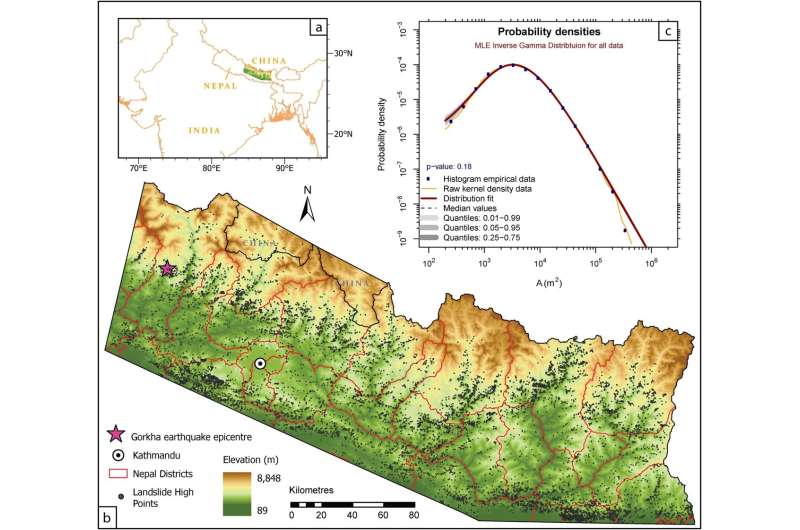Extreme weather and earthquakes need greater attention when examining Nepal's landslides

The 2015 Gorkha earthquake caused devastation across vast areas of Nepal, killing almost 9,000 people and leaving 3.5 million homeless.
However, it also triggered thousands of landslides that caused additional destruction to communities and infrastructure—and prompted landslides in the subsequent monsoon season to occur at steeper and higher hillslopes than in average years.
That is according to new research, which provided an unprecedented assessment of how landslide distributions can be affected by extreme events.
Led by scientists from the University of Plymouth and University of East Anglia, the study was developed using a database of almost 13,000 recorded monsoon-triggered landslides spanning a period of almost 30 years.
This time period included several years known to have been impacted by extreme events (storms, the 2015 earthquake and floods) and offered a unique opportunity to assess how landslide occurrence changes through space and time in response to both extreme weather and earthquakes.
The results showed that landslide distributions varied significantly over the 30-year period, particularly in the years impacted by storms (1993 and 2002), earthquakes (2015) and floods (2017).
This, the researchers say, is a problem as current risk models typically assume that landslide distributions do not change through time, and so cannot accurately forecast landslide occurrence during and following extreme events.
With landslides currently accounting for 17% of all fatalities due to natural hazards—and World Bank research suggesting more than 66 million people live in high risk landslide regions—this study highlights the compelling need to improve current landslide risk models in order to better manage and mitigate landslide hazard.
The study is published in the Journal of Geophysical Research: Earth Surface, and also involved researchers from the University of Exeter and international engineering consultancy firm, AECOM.
Ph.D. student Joshua Jones, the study's lead author, said:
"Landslides continue to pose a major hazard to communities worldwide, particularly those in dynamic, high-mountain regions. Current models used to assess landslide susceptibility assume that landslide distributions don't change through time. This assumption is largely accepted, as rarely can scientists obtain enough landslide data to systematically look at how landslide distributions actually vary through time. The novelty of this study is that with a new 30-year database, we show that this assumption doesn't actually hold true, with landslide distributions changing significantly in response to extreme weather and earthquakes. Furthermore, we show that current susceptibility models cannot accurately account for these changes, suggesting that better time-dependent models are required to improve landslide forecasting and hazard management."
This region of Nepal was selected as the focus for the research for several reasons.
Its dynamic geology, high topography and monsoonal climate make landslides in this region extremely pervasive, with an average of 78 landslide-related fatalities per year. As such, the country can directly benefit from an improved understanding of landslide susceptibility.
Furthermore, this particular region has also experienced several extreme events over the past three decades, presenting a unique opportunity to investigate how landslide spatial distributions vary in response to a range of different processes.
In examining the landslide database, the researchers looked at 17 possible contributing factors including elevation, slope angle, bedrock geology, the distance to channels or roads, and both peak and average rainfall levels.
They also assessed levels of permafrost in landslide locations, and how this might be impacted in the future as a result of the warming global climate.
Dr. Sarah Boulton, Associate Professor in Active and Neotectonics at the University of Plymouth, said:
"Tragically landslides continue to pose significant risk to populations worldwide, especially when combined with other extreme events such as earthquakes or storms. Our new research highlights that in Nepal, during these multi-hazard events, the characteristics of the resulting landslides are different to those produced during a typical monsoon season triggered by rainfall alone.
"Unfortunately, existing models used in landslide analysis assume that landslide characteristics stay the same and as a result would not be able to correctly forecast landsliding under such scenarios, which may become more frequent in a warming climate and with higher populations. These new data potentially allow more accurate landslide models to be developed, which could help to save lives."
More information: J. N. Jones et al, Temporal Variations in Landslide Distributions Following Extreme Events: Implications for Landslide Susceptibility Modeling, Journal of Geophysical Research: Earth Surface (2021). DOI: 10.1029/2021JF006067
Provided by University of Plymouth




















